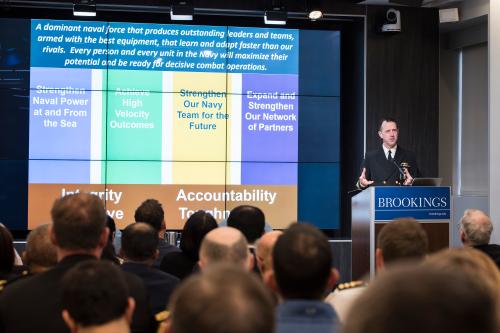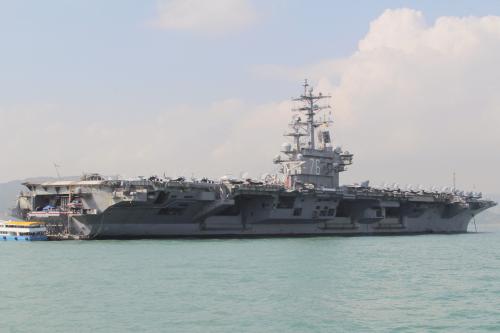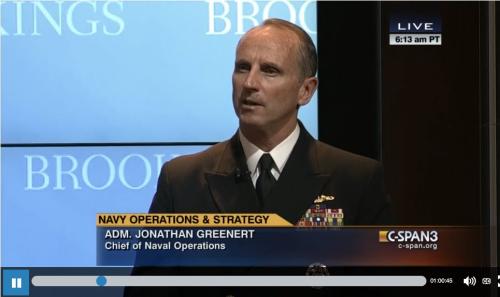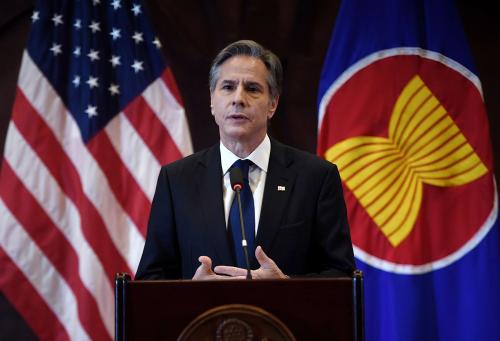Amid a changing global environment—particularly in technology and information arenas—the U.S. Navy faces new challenges, including competition for maritime security and a high-quality workforce, as well as the need for improved acquisition processes and modernization in some areas. On April 27, the Center for 21st Century Security and Intelligence at Brookings hosted an event focused on priorities for the Navy. Admiral John Richardson, chief of naval operations, opened with remarks before turning to a discussion with Brookings Senior Fellow Michael O’Hanlon and the audience.
Admiral Richardson identified key issues for the future of the Navy, including urgency, competition, readiness, and innovation.
On the first, he called for recapturing “a sense of urgency to retain our place in the world.” That mindset will allow the military overall—and the Navy in particular—to become as competitive as it needs to be, according to Richardson. Reminding the audience that people have been going to sea for 10,000 years, he reported (to his own astonishment) that “the amount of traffic has increased by a factor of four in the last 25 years.”
On competition, Richardson highlighted several world actors in particular:
- China – The country has grown from a regional to a global power in recent decades. He noted that China’s shipbuilding is on pace to exceed the U.S. fleet by 2030, and that China has launched more military ships than any other country since 2013. He also noted that Chinese ships are operating at greater distances from home, during a time when the country’s global engagement is as high as it has ever been.
- Russia – Admiral Richardson pointed to Syria, where Russia has deployed forces in support of Syrian President Bashar Assad. Moscow is now testing new systems and new techniques, building new classes of ships and submarines, and its technology.
- North Korea, Iran, and violent extremism – With North Korea, there is a new level of escalation and unpredictability. Iran has a small but growing fleet; they have been provocative in the Persian Gulf while also willing to engage in proxy conflict, Richardson said. Finally, the challenge of violent extremism continues to morph, and extremist groups involved have generally been adept at using new technology.
Richardson was careful to make a point that our competitors are not slowing down. He wondered aloud: “What should we do to address that?” Thus far, the answer has been to study the competition, create a plan, adequately fund the plan, then execute the plan. But the lack of stable and predictable funding recently has taken a “tremendous toll on the ability to execute.”
Richardson applauded agreements like the Code for Unplanned Encounters at Sea. This agreement, initially between the United States and China, has helped to keep random incidents at sea from escalating. Since its signing, many other nations in the Asia-Pacific have now joined.
While acknowledging overstretch during the past 15 years—and particularly lately, given the rebalance to the Pacific—Richardson said: “The fleet is operating with precision and skill. It is a bright spot and I give fleet commanders tremendous credit.” Facing a high tempo of operations, the Navy continues to meet recruiting goals, and that “speaks to value and integrity of the service orientation of our current generation.”
When O’Hanlon asked about readiness amidst this tempo, Richardson said “we won’t send any ships out that are not fully certified,” adding: “we have 100 ships right now forward deployed around the world, about 75,000 sailors.” But while deployed naval forces are ready, that won’t be sufficient for a high-end conflict. Reinforcements need to be ready as well, and Richardson acknowledged that “it’s becoming harder and harder to get that team out the door fully ready.”
“If we just have a resource-uninformed wish list for the future, it is worth the paper it is written on, or maybe not even.”
On fiscal constraints, and how they might impact the objective of growing the Navy from today’s 275 ships to around 350 ships in coming decades, Richardson said that while there is “consensus that the future security environment is going to demand more Navy,” rushing to build and operate ships under today’s concepts would likely prove a miscalculation. He later returned to this idea, stating: “If we just have a resource-uninformed wish list for the future, it is worth the paper it is written on, or maybe not even.”
Alluding to an ongoing discussion at the Pentagon, Richardson indicated the public will hear more on the hopes for the future of the U.S. Navy soon. In the meantime, it is worth remembering that the positives far outweigh the negatives, and the force is accomplishing what it is setting out to do.
As their discussion closed, O’Hanlon queried Richardson about his top concerns ahead, offering cyber and space vulnerability, missiles, or submarine threats. Richardson answered that “all of those are in group one” when it comes to priorities. The United States still enjoys an advantage undersea, but it is fleeting, he said, adding that on missiles, we need to innovate more. And space and cyber are relatively new terrains. These areas are a “tremendous challenge” going forward. “All are front and center,” Richardson concluded.






Commentary
How to ensure that the U.S. Navy remains effective
May 3, 2017